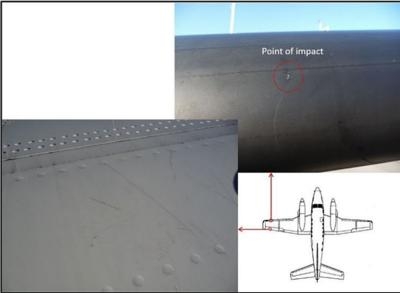Recommends Amending The Canadian Aviation Regulations In Response To The Incident
The Transportation Board Canada has released its final report on a collision between a Beechcraft King Air A100 (registration C-GJBV, serial number B 100) operated by Sky Jet M.G. Inc and what the pilots described as a UAV on October 12, 2017.

The King Air was operating as Flight SJ512. It was on an instrument flight rules flight from Rouyn-Noranda Airport (CYUY) (Quebec) to Québec/Jean-Lesage International Airport (CYQB) (Quebec) with 2 pilots and 6 passengers on board.
As the aircraft approached CYQB, the aircraft was cleared for a visual approach to Runway 24. On final approach, the flight crew said they observed a drone, about the size of a dinner plate, in front of the left wing. The pilot had no time to take evasive action. The impact was unavoidable, and the drone disintegrated.
The collision took place at 1802 EDT at an altitude of 2,500 feet above sea level (ASL) and approximately 7 nautical miles from the midpoint of Runway 24.
At 1804, the crew declared an emergency, then completed the landing without further incident. There were no injuries.
The damage was limited to a dent at the point of impact on the left wing de-icing boot, as well as scratches on the upper surface of the left wing. The damage was minor and had no effect on the airworthiness of the aircraft. The aircraft was returned to service the same day.
The investigation was unable to identify the operator of the drone involved in the collision with the Sky Jet M.G. Inc. aircraft. No debris from the drone could be found, and it could not be determined with certainty whether it was used for recreational or non-recreational purposes.
The CYQB control tower had not been informed of any UAV activity in the Class C control zone under its jurisdiction, no SFOC had been issued, and no Notices to Airmen had reported any such activity on 12 October 2017. The presence of a drone within controlled airspace had not been detected by the radar in the CYQB control tower. Because neither TC nor NAV CANADA was aware of this drone operation in the control zone, the investigation concluded that the regulations governing the operation of drones were not followed.

Depending on the type of offence and its severity, a drone operator who contravenes the CARs or Interim Order No. 8 may be subject to an administrative monetary penalty (a fine up to $25,000 Canadian) imposed by TC, and in some cases, may be found guilty of an indictable offence or an offence punishable on summary conviction.
It is easy for any consumer to purchase a drone without being informed of any regulations governing its use; retailers are under no obligation to inform consumers of the regulations in force.
In 2016, TC issued 4381 SFOCs for UAVs, as compared to 66 in 2010. Given this increase in the use of UAVs and in SFOC applications, TC's administrative system is no longer able to meet the usual 20-day service standard for processing and issuing SFOCs. As a result, there have been negative effects for UAV operators, such as delays to business operations and industry's ability to plan activities.
TC has proposed amendments to the current regulations governing the operation of drones for both recreational and non-recreational purposes. The recommended changes are described in Part I of the Canada Gazette. The regulatory proposal is primarily aimed at reducing the potential risks that unmanned aircraft systems (UAS) pose to the safety of manned aircraft and to people and property on the ground.
In its rationale for the Regulations Amending the Canadian Aviation Regulations (Unmanned Aircraft Systems), TC stated the following:
"The likelihood of further incidents was further analyzed by Transport Canada and based on Air Occurrence Report (AOR) incidents collected since January 2014. In 2014, there were 41 incidents of non-compliance reported. In 2015, the number of reported incidents more than doubled to 86, and a total of 148 incidents near aerodromes were reported in 2016. A few of the reports include flights near people or vehicles, but the existing AOR system tends to rely on pilot and air traffic controller reports, therefore incidents near people, vehicles, or property on the ground tend to be underrepresented in the data."
In this incident, there were no injuries and only minor damage to the aircraft. However, the use of drones near an aerodrome or within controlled airspace poses a serious risk to aviation safety. For this reason, all recreational and non-recreational drone users must be knowledgeable about and comply with the regulations, including the requirement to operate within line of sight. Users must also familiarize themselves with the different classes of airspace to ensure they comply with the regulations and avoid conflicts with aircraft. In addition, it is important for the public to notify TC when observing the use of a drone near an aerodrome so that TC can take appropriate action.
(Source: Transportation Safety Board Canada. Images provided)
 ANN's Daily Aero-Term (04.24.24): Runway Lead-in Light System
ANN's Daily Aero-Term (04.24.24): Runway Lead-in Light System ANN's Daily Aero-Linx (04.24.24)
ANN's Daily Aero-Linx (04.24.24) Aero-FAQ: Dave Juwel's Aviation Marketing Stories -- ITBOA BNITBOB
Aero-FAQ: Dave Juwel's Aviation Marketing Stories -- ITBOA BNITBOB Classic Aero-TV: Best Seat in The House -- 'Inside' The AeroShell Aerobatic Team
Classic Aero-TV: Best Seat in The House -- 'Inside' The AeroShell Aerobatic Team Airborne Affordable Flyers 04.18.24: CarbonCub UL, Fisher, Affordable Flyer Expo
Airborne Affordable Flyers 04.18.24: CarbonCub UL, Fisher, Affordable Flyer Expo




